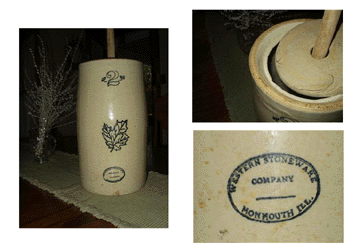
butter churn (artifact #23)
(Phillips collection)

The crock is 13 1/4" tall and a little over 4" diameter. That is about right for a 1-gallon capacity. I don't know what the "2" stands for. It is glazed on the inside. Dale and Susan Phillips salvaged it from her grandpa Albert's work shop in Burden, Kansas in about 1982.
Hilda and Albert Franklin bought a lot of stuff they thought they would need when we first arrived in Arkansas. Nothing was new, but picked up at auction in Fayetteville. It turned out that, although our cow made enough milk to use a 1-gallon churn, we couldn't use that much ourselves. Butter sold for about the same price as honey (15¢ a pound) and wasn't profitable. I don't think the churn was ever used. Why did the folks keep it? Only reason I can think of is as a keepsake from the farm.
There was a market for sweet cream. Daddy bought a cream separator, a big iron can with high-speed turbine-looking blades, to separate the cream without waiting for it to rise to the top. This sweet cream would not churn into butter well. Left to separate naturally, the cream rose to the top in a solid well-defined layer in a day or two. We used a fruit jar to shake this skimmed cream into butter and buttermilk for our own use. Skim milk has to sit longer to clabber before cottage cheese can be successfully squeezed into curds and whey.
When our cow was eating lespedeza through spring and summer, she gave four to five gallons of milk a day (six right after she came fresh). This production tapered to three gallons in the winter and the cow dries up before she calves. The milk was about 1/4 cream (40% pure butter fat). This amounted to a gallon of cream per day which could be converted to two or three pounds of butter daily. A quart fruit jar, with enough space to shake, would make a half pound of butter. This was from a small cow of Jersey-Guernsey mix. I've quoted these figures to farmers, whose dairy cattle didn't eat as well, and got such disbelief to make me out to be a liar. But as Charley Doyle said about that, "We know what we know!"
Lord, we ate well, although some of it was seasonal. We grew all of our own garden veggies of course, canning or storing the surplus in the root cellar. Eggs and fried chicken were staples and there was always baked bread or soda biscuits. We ate berries, canned or fresh, buried in cream and sugar, three glasses of whole milk (10% butterfat) daily, and fresh and cured pork. Primitive people, hunters and gatherers, have a natural craving for animal fat. In fact, Aleut Eskimos' lives revolve around the quest for fat. And we all died of coronary disease at a young age. We had the meanest, healthiest flock of chickens because they got the dairy surplus and byproducts. Our pigs got a lot of it also. That was quite a cow.
Bill Franklin 9-03